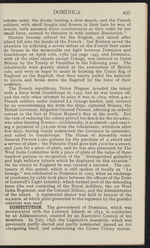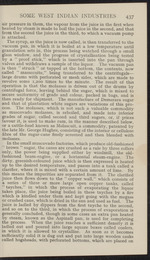|
|
|
Your search within this document for 'batá,drums' resulted in two matching pages.
|
| 1 |
 |
“...DOMINICA
*37
solemn order, the drums beating a slow march, and the French
soldiers, with small boughs and flowers in their hats by way of
laurels, with assumed fierce countenances as they came by our
small force, seemed to threaten it with instant dissolution."
Matters became critical for the English, and island after
island fell into the hands of the French ; but Rodney saved the
situation by inflicting a severe defeat on the French fleet under
de Grasse in the memorable sea fight between Dominica and
Guadeloupe on April 12th, 1782 (see page 244), and Dominica,
with all the other islands except Tobago, was restored to Great
Britain by the Treaty of Versailles in the following year. The
inhabitants were greatly elated at the restoration of British
rule, and were so eager to assist in hoisting the Union flag of
England on the flagstaff, that they nearly pulled the halliards
to pieces and broke down the flagstaff by the force of their
numbers.
The French republican, Victor Hugues, invaded...”
|
|
| 2 |
 |
“...it is boiled at a low temperature until
granulation sets in, this process being watched through a small
glass window, and the progress of crystallisation being tested
by a proof stick," which is inserted into the pan through
valves and withdraws a sample of the liquor. The vacuum pan
is then " struck " or tapped at the bottom, the contents, now
called " massecuite," being transferred to the centrifugals—
large drums with perforated or mesh sides, which are made to
revolve some 1,200 times to the minute. The result of this
operation is that the molasses is driven out of the drums by
centrifugal force, leaving behind the sugar, which is mixed to
secure uniformity of grade and colour, packed in bags, and is
then ready for shipment. The manufacture of Demerara sugar
and that of plantation white sugars are variations of this pro-
cess. The molasses, which is not such a valuable commodity
as muscovado molasses, is reboiled, and made into inferior
grades of sugar, called second and third sugars...”
|
|
|
